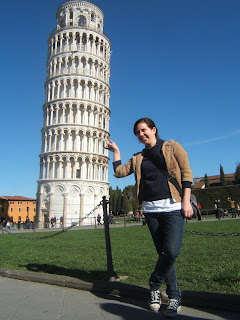I finally went on an infamous Helen field trip. Helen is our early renaissance and high renaissance art history professor and she is notorious for high paced compact field trips. But, a free trip is a free trip so last Saturday I found myself on a bus for a whirl wind tour of both
Pisa and
Lucca in one day. Helen field trips are actually pretty great, especially if you are not actually in the class and have no pressure of memorizing facts that may be on the midterm. She has a mic and headset system so you listen to the entire lecture from personal headphones. This provided two luxuries; I could hear everything and when I didn’t feel like being lectured to at the moment I could take my headphones off.

Entertaining things learned in Pisa…
The famous leaning tower is actual the bell tower of Pisa’s duomo complex (a duomo is the most important cathedral in a town or city). As of today it has about a 5 degree lean and had to under go a ton of construction and planning after a period of the tilt steadily increasing. The tower’s tilt is now under control and has been determined as stable.
The baptistery has crazy acoustics. One sung note will echo through the halls for about 5 seconds after the note is finished, making any mediocre singing sounds fabulous. They give acoustic demonstrations performed by the janitorial staff. In other words, a singing test is part of the application to become a janitor in Pisa’s baptistery.

Sinopias are fresco sketches and are named for their reddish tone. We saw an entire gallery of these sketches that are normally never seen because they are in a layer underneath the fresco plaster. After WWII some major frescos in Pisa’s cemetery complex were partially destroyed to the point that officials moved them off the outdoor walls to a safer location. The sketches were also removed from the wall at this time and now hang in a nearby gallery.

Random fun facts from Lucca…
A ton of buildings and complexes are built over layers of Roman ruins. There were two distinct points where you could easily see the different parts of history come together in the architecture.
The first location was a town square built on top of the foundation of a Roman amphitheater. The placement of the houses and the outside walls reflect this history.
The cathedral S. Giovanni and Reparata recently reopened after being completely excavated for ancient ruins. Layers of Roman, Early Christian and early medieval ruins lie underneath the floors of the church. They are opened up to the public to wander around in and look at the different areas ranging from an old Roman bathhouse to a brick studio from later in history.






2 comments:
Thanks for the art lesson. I love the picture of you holding up the tower. It might have to replace the Florence bridge as my computer background. The kids will love it. Julie
the mic reminds me of hamman
Post a Comment